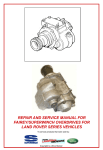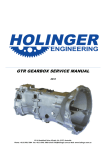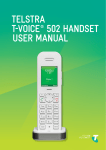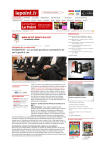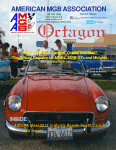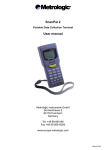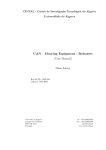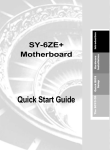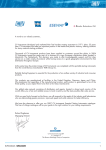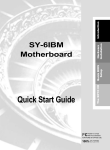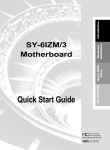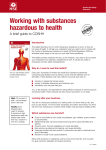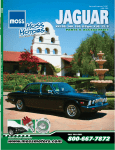Download Supplemental Information & Instructions
Transcript
M:\Product Information\128-225_3H2865\Instructions\Drafts\128-225_3H2865_461-868_3H2865K_INST.docx Created on 11 February by Michael Grant Revised by Michael Grant, Mick Pratt & Davis Aidnik on 11 March 2014 1 Supplemental Information & Instructions for 2 4 128-225 or 3H2865 Bearing Assembly, 20 Needle Roller and/or 461-868 or 3H2865K Layshaft Bearing Kit w/ Spacer Tube 5 MGA (all), MGB w/standard gearbox to engine number GB74719 3 6 7 The 461-868 or 3H2865K Layshaft Bearing Kit 8 1a A 9 10 11 MGB w/overdrive gearbox to engine number GB74528 12 13 14 15 16 17 18 19 20 21 22 23 24 25 26 27 28 29 30 31 32 33 34 35 36 37 38 39 40 41 42 43 44 45 46 47 48 49 50 51 52 53 1d 1c 1b 1e 1g 1f 1h 1a Each bearing assembly comes in the original box. 1b Each bearing assembly is wrapped in protective paper 1c Once unwrapped the assembly inside the outer shell is visible. 1d The special retaining washers with the “lip” or “”flange” on the inner edge. 1e Some, but not all bearing assemblies come with one snap ring 1f The 20 needle bearings. Note the pins on each end – these are trapped under the lip or flange of the retaining washers (11d) 1g We include 4 snap rings with each kit ; any that you get with a bearing assembly will be “extra”. 1h The spacer tube, which we make on the Moss Machine Shop We suggest you leave the bearing assembly (1c) alone until you have read the rest of this… the bearing assembly is a lot easier to deal with as a unit than as 20+ separate bits. About this Kit….. The 461-868 or 3H2865K Layshaft Bearing Kit represents a return to the original design specification for the layshaft bearings for the three-synchro gearbox fitted to the MGA and early MGB. By reintroducing the original bearings and dropping the caged bearings sold for this application, Moss Motors has eliminated what many have blamed for the excessive wear of the layshaft- the caged roller bearings that cut the number of load bearing rollers in half. This kit is intended for stock engines in a street application where your laygear does not need replacing. If you need a laygear, or if you have a modified engine and/or a more spirited driving style, we suggest our Uprated Laygear Kit (461-571 or 22H54K). Developed by Moss Europe, this is another Moss exclusive. Built around the stock layshaft, it comes with a new laygear fitted with uncaged needle roller bearings that are longer than stock, effectively doubling the load bearing area over the original MG design. It is the most durable package we offer for the early layshaft/laygear. Please see our website www.mossmotors.com for more information on these options. For pretty much everything but the fire-breathing race car, Moss has a solution. And everyone wants to know where we found them… Suffice it to say we discovered a substantial quantity in a warehouse in England, and we bought them all. The bearings are from two manufacturers. The yellow boxed bearings (shown above) are from RHP and the blue boxed bearings (not shown) are from R&M. These bearings have not been manufactured for many years. For us, this is the ultimate “barn find”. Page 1 of 6 M:\Product Information\128-225_3H2865\Instructions\Drafts\128-225_3H2865_461-868_3H2865K_INST.docx Created on 11 February by Michael Grant Revised by Michael Grant, Mick Pratt & Davis Aidnik on 11 March 2014 54 55 56 57 58 59 60 61 62 63 64 65 66 67 68 69 70 71 72 73 74 75 76 77 2a 2b A Little History….. Fig 2 The MGA and early MGB three synchro gearbox share a layshaft that is 0.645” in diameter, which is smaller than the later shafts. Initially, three 3H2865 layshaft bearings were used, each being made up of 20 loose needle roller bearings (2b) that had pins on each end. These pins were “trapped” under the lip of the special washers (2a) supplied as part of the bearing assembly. Two of the three th bearing sets were fitted on the 4 gear end of the layshaft (toward the front), st leaving a single bearing set for the 1 gear end toward the rear. 2b 2b As supplies of the 3H2865 loose needle bearing assembly dried up, it was replaced by AAU3052, a caged needle roller bearing assembly (3a). While the caged assembly greatly simplified the assembly procedure, each one only has 11 or 12 needles (depending on the manufacturer) compared to the 20 in the original bearings. In time the caged bearings became associated with premature layshaft wear. The wear is always most severe at the first gear end of the th layshaft (toward the rear) because it is more heavily loaded than the 4 gear end (toward the front). It certainly does not help that the first gear end is th supported by a single bearing assembly while the 4 gear end has two. Fig 3 3a The three layshafts in Figure 4 show a progression from almost no wear (4a) to very severe wear (4c).There is a great deal of discussion on the web about this problem, and there are several causes mentioned, one being the reduced load bearing surface available related to the number of needles in the caged bearing assembly. 78 79 80 81 82 83 84 85 86 87 88 89 90 91 92 93 94 95 96 97 98 99 100 101 102 103 104 105 106 How can I tell if my layshaft is “going”? Anyone can tell if you need a new layshaft with the old one in hand. John Esposito (Quantum Mechanics, British Gearbox specialist) explains how you can get a pretty good idea about the condition of the layshaft and layshaft bearings just by listening to the 3-synchro gearbox. Fig 4 4c th 4 gear is your bench mark. It is direct drive; the laygear is not loaded or involved, so 4th is very quiet. rd In 3 gear the laygear is engaged. If the layshaft and layshaft bearings are fine, it th should not be any noisier than 4 gear. If there is any increase in noise when th rd moving from 4 to 3 , the layshaft is suspect. nd Same thing applies to 2 gear – the laygear is engaged. If there is any increase rd nd in noise when moving from 3 to 2 , the layshaft/layshaft bearing problems are confirmed. st 1 gear is going to be ignored because it uses straight cut gears which are inherently noisy. That noise will mask any layshaft related noise that might be there. 4b 4a The layshaft/layshaft bearing related noise you can hear when down shifting can also be heard when up nd rd th shifting. If 2 gear is noisy, and the noise decreases going to 3 , and it goes away after shifting to 4 , the layshaft/layshaft bearings are the probable cause. And another good rule of thumb – when it is time to change out the clutch, it is time to check the layshaft and the inside of the laygear for wear. If you detect layshaft/layshaft bearing noise, plan on dealing with it soon. It will not be long before more serious problems (like broken gear teeth) develop. You can avoid all that by taking action quickly. It is much easier (and much less expensive) to replace the layshaft and bearings by themselves without adding a gear or two to the bill. Page 2 of 6 M:\Product Information\128-225_3H2865\Instructions\Drafts\128-225_3H2865_461-868_3H2865K_INST.docx Created on 11 February by Michael Grant Revised by Michael Grant, Mick Pratt & Davis Aidnik on 11 March 2014 107 108 109 110 111 112 113 114 115 Before you install anything… Make sure you have a transmission with the 0.645” diameter layshaft and that it can be rebuilt. Nobody should go to the trouble of pulling a gearbox apart without a complete inspection. Plan on replacing all worn components – usually synchros, bearings, gaskets and seals. The factory workshop manual is essential and Barney Gaylord’s website (mgaguru.com) has a good section on disassembly and inspection of the gearbox. Both will tell you to carefully check the gears, and we’ll say pay particular attention to the inside of the laygear where the needle roller bearings ride. If the surface inside the laygear is worn, renewing the bearings will be a bad investment- you need a new laygear. 116 117 118 119 120 121 122 123 124 125 126 127 128 129 130 131 132 133 134 135 136 137 138 139 140 141 142 143 144 145 146 147 148 149 150 151 152 153 154 155 156 157 158 159 160 Why Not Just Tell People to Follow the Factory Workshop Manual? Section F.5 (June 1956 revision, at right) from the MGA Service Manual has been inserted here for your review. Fig 5 We found it to be not entirely helpful. First and foremost, neither the MGA or MGB workshop manuals address the pre-assembled bearing. Most likely, they were not available until well after the manuals were written. However, if you have never had your gearbox apart before, we felt there was too much left to be discovered the hard way. Given the frustration and aggravation inherent in a “trial & error” process and the potential for an expensive mistake or two, providing instructions seemed to be essential. We hope to develop these instructions further using your tips and suggestions. So please – if you have come up with a better way let us know so we can share. 6b 6 a Before we start, take a closer look at the bearing assembly. 6a The thin outer shell used to hold the assembly together until it is installed. 6a Fig 6 6b One of three folded-over edges holding the bearing in. 6c 6c The rolled over lip at the front securing the bearing. 6f 6f 6d One of 2 special retaining washers holding the needles in place. 6e The thin snap ring supplied in some bearing assemblies 6d 6f The needle bearings. Page 3 of 6 6e 6 e M:\Product Information\128-225_3H2865\Instructions\Drafts\128-225_3H2865_461-868_3H2865K_INST.docx Created on 11 February by Michael Grant Revised by Michael Grant, Mick Pratt & Davis Aidnik on 11 March 2014 161 162 163 164 165 166 167 168 169 170 171 172 173 174 175 176 177 178 179 180 181 182 183 184 185 186 187 How it All Goes Together th 4 gear end, or “Big End” of Laygear Fig 7 th 4 gear end 1st gear end, or “Small End” of Laygear 7n 1st gear end 7 k 7j 7g 7a 7f 7g b 7b 7l 7h 7d 7d 7h 7c 7e 7i b Moss Description Europe 7abc 128-225 3H2865 Bearing Assembly, as originally fitted 7d NPN NPN Retaining washer, w/lip 7e NPN NPN Needle Roller Bearings, loose (uncaged) 7f NPN NPN Snap Ring (included with some bearings) 7ghi 326-190 11G3027 Circlip or Snap Ring 7j 461-580 11G3026 Tube, layshaft bearing spacer The following items are not included - thay are illustrated & listed 7k 461-590 1G3576 Thrust Washer, Front (0.154") 7l 461-600 1G3577 Thrust washer rear, (0.155) 461-610 1G3578 Thrust washer rear, (0.157) 461-620 1G3579 Thrust washer rear, (0.158) 461-630 1G3580 Thrust washer rear, (0.163) 7m 461-560 1H3305 Layshaft, 0.645" nominal diameter 7n 461-570 22H54 Laygear, for 1H3305 layshaft (If you need a laygear, consider the 461-571 Laygear Kit Ref Moss US 188 189 190 191 192 193 194 195 Page 4 of 6 Notes 3 in kit 2 per bearing assembly 20 per bearing assembly slightly smaller than 326-190 4 included in kit 1 in kit here for clarity. M:\Product Information\128-225_3H2865\Instructions\Drafts\128-225_3H2865_461-868_3H2865K_INST.docx Created on 11 February by Michael Grant Revised by Michael Grant, Mick Pratt & Davis Aidnik on 11 March 2014 196 197 198 199 200 201 202 203 204 205 206 207 208 209 210 211 212 213 214 215 216 217 218 219 220 221 222 223 224 225 226 227 228 229 230 231 232 233 234 235 236 237 238 239 240 241 242 243 244 245 246 247 248 249 250 251 Installation Tips (refer to Fig 7) 1. 2. 3. 4. 5. 6. 7. 8. 9. 10. 11. 12. 13. 14. 15. Fig 8 About Snap Rings. Four snap rings are needed. Some of the bearing assemblies come with a snap ring, but some don’t so we include four snap rings in the kit. If you end up with an extra snap ring-great - they are handy in case one popped into the wrong groove; removing them usually damages them enough to make them unusable. The first snap ring to install is (7h). Shine a light down inside the laygear from the 4th gear (big) end– you can see 3 snap ring grooves clearly. The groove for the (7h) snap ring is the 3 rd groove, 1 ¾” deep inside the laygear and therefore hardest to fit. Hold the snap ring (7h) it so that it is 90º to the long axis of the laygear (Fig 9) Fig 9 th and insert it in the opening at the 4 gear end (aka “the big or front end”) of the 89 laygear using a pair of long needle nose pliers. Using the same pliers, push the snap ring straight in until it is past both of the outer snap ring grooves. Once safely past the 2 outer grooves, rotate the (7h) snap ring back 90º so that it is in full contact with the bore of the laygear. Push the snap ring into the internal snap ring groove with a suitably sized brass drift, brass tube, or a Craftsman 5/8” socket (0.862” OD) on a long extension as shown in Fig 9. Note Fig 10 that the snap ring is not very wide – if the nose of the socket is rounded, it may not work very well. In that case, flip the socket around and use the “back” to push the snap ring. The “back of the socket is usually unaffected by wear and should make good contact with the snap ring. You can square the snap ring up in the bore by running a second socket in from the other end. When the sockets are pressed together, the snap ring will “square up” in the laygear bore. The next step will be to install the (7b) set of needle bearings in the laygear and press it against the (7h) snap ring you just fitted. Pick one of the three bearing assemblies. Liberally apply grease to the bearing whilst still in its outer shell. This provides sticktion and will help in keeping the bearing Fig 11 together. Make sure all the rollers inside the outer shell are running parallel to the long axis of the assembly and not at an angle. Locate the three bent over sections of the lip shown in Fig 11. These hold the bearing assembly inside the shell. Using a pair of long needle nose pliers, straighten out the bent sections completely. The outer shell material is quite thin and it is easily straightened. Make sure the lip of the outer shell will not interfere with the bearing assembly when it is pushed out of the shell. This is now “the open end of the bearing assembly.” Have laygear lying flat on the workbench - not on its end. th Insert the layshaft into the laygear from the 4 gear (big or front) end. Using the layshaft as a guide, slide the open end of the bearing assembly (including the outer shell) onto the layshaft. Slide the bearing assembly up the shaft until the outer shell touches the laygear. The outer shell of the bearing assembly will not fit inside the laygear- it stays outside. The next step is to push the bearing assembly out of the shell and into the laygear. Using the small end of the tubular drift described above, start pushing the bearing out of the shell and into the laygear. As soon as the snap ring in the bearing assembly clears the end of the outer shell, stop. The reason for stopping is that this 2nd snap ring (7g) must be pushed over the outer snap ring groove. If you simply push it in straight, it will pop into the outer groove and you will have fun trying to get it out. Remove the tubular drift and extract the snap ring and set it aside. Use the full-sized end of the tubular drift to push the bearing with the two retaining washers into the layshaft until the inner retaining washer comes up against the first snap ring (7h) you installed. Remove the layshaft carefully from the laygear while you press on the tubular drift, holding the bearing assembly in position as you withdraw the layshaft. Now remove the drift. Once the bearing assembly is seated, the two special retaining washers overlap the pins on the ends of the needle bearings, making it impossible for the needles to “fall out” when the layshaft is removed. In reality, the grease on the bearings and on the layshaft would hold the needles in place without the special washers. Install the (7g) snap ring and push it over the outer snap ring groove following the procedure used in steps 3-4-5 above. Once the (7g) snap ring is in the proper groove, the inner bearing is secured and you can proceed to install the outer or second bearing (7a). Page 5 of 6 M:\Product Information\128-225_3H2865\Instructions\Drafts\128-225_3H2865_461-868_3H2865K_INST.docx Created on 11 February by Michael Grant Revised by Michael Grant, Mick Pratt & Davis Aidnik on 11 March 2014 252 253 254 255 256 257 258 259 260 261 262 263 264 265 266 267 268 269 270 271 272 273 274 275 276 277 278 279 280 281 282 283 284 285 286 287 288 th 16. To install bearing (7a) on the 4 gear or front end, you will be repeating steps 5 – 12. 17. As soon as the snap ring (if included) in the (7a) bearing assembly clears the end of the outer shell, stop. 18. You may use the snap ring from the assembly or, if you wish, you can replace it with one of the four 326-190 (11G3027) snap rings supplied in the kit. Insert the snap ring in the outer snap ring groove. This completes the installation of the two bearings and the three snap rings in the 4 th gear or front end of the laygear. 19. Moving to the 1st gear end of the laygear, we have only a spacer tube (7h), one bearing (7c) and the outer snap ring (7i) to deal with, and they are fitted in that order. st 20. Insert the spacer tube (7j) into the 1 gear end of the laygear and press it home. It will stop when it comes up against the inner most of the three snap rings (7h) installed from the 4 th gear end. rd 21. Install the 3 bearing assembly (7c), using steps 4-11 (above) as a guide. 22. You may use the snap ring from the assembly if there was one, or, if you wish, you can replace it with one of the four 326-190 (11G3027) supplied in the kit. Insert the snap ring (7i) in the outer snap ring groove. This completes the installation of the spacer tube, bearing and the snap ring in the 1st gear or back end of the laygear. Some Final Questions, and one last Tip… The most obvious question is this: How long can I expect this bearing set to last? The answer is going to depend on the state of tune of the engine and how you drive, but remember that this is the original three-bearing configuration the factory used in the MGA/early MGB gearbox, and it has much greater load bearing capacity than the caged needle bearings fitted as replacements for many years. Properly maintained, you can expect 50 to 75,000 miles with a stock MGA engine driven normally on the street. Almost forgot the most important tip of all – how do you remove the 2 old snap rings that are down inside the laygear? The outer snap rings can be levered out fairly easily. The two snap rings the trap the inner bearing must be bashed with a brass drift and a hammer until the snap ring is either bent out of shape or actually broken. Honest – we asked a lot of folks that rebuild these for a living. Be careful not to damage the bearing surface (which is why we specify a brass drift). Special thanks to John Esposito of Quantum Mechanics ([email protected]), Barney Gaylord (mgaguru.com) the R&D Team at Moss Europe, particularly Michael Pratt, and David Aidnik, Product Development Engineer at Moss Motors, Ltd. Notes 289 290 291 292 293 294 295 296 297 298 299 Any suggestions that you may have that will improve the information (especially detailed installation notes) are welcome. Please use the simple email form on the “Contact Us” page on the Moss website:http://www.mossmotors.com/AboutMoss/ContactUs.aspxIf you prefer, you may call our Technical Services Department at 805-681-3411. So many people call us for help that we are often not able to answer the calls as fast as we’d like, and you may be asked to leave a message. We respond to every call for help as quickly as we can, which is normally within 2 business days, but when the volume of calls and emails is high, it may take longer. We apologize in advance for the inconvenience. Moss Motors, Ltd. 440 Rutherford Street, Goleta, California 93117 In the US & Canada Toll Free (800) 667-7872 FAX (805) 692-2510 (805) 681-3400 Moss Europe Ltd. Hampton Farm Industrial Estate, Hampton Road West, Hanworth Middlesex, TW13 6DB In the UK: 020-8867-2020 FAX: 020-8867-2030 6 of 6 Instruction Page Sheet 128-225_3H2865_461-868_3H2865K March 2014






